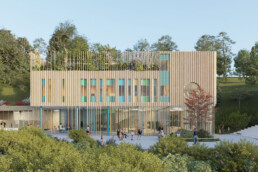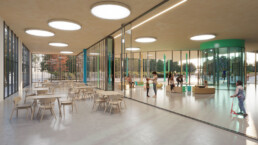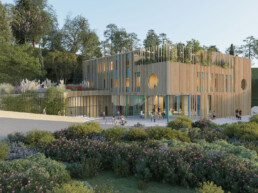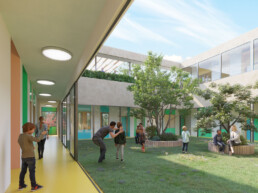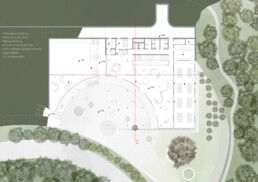Castelnuovo di Porto (RM), Italy
Scuola Primaria a Castelnuovo di Porto
Year: 2022
Client: Ministero della Cultura
Area: 2.242 sqm
Status: Competition
Design: Studio Costa Architecture
CDO: A. Costa
Design Director: V. Didier
Project Leader: P. Mencacci
Project Manager: V. Didier
Visualizer: Opifex Laboratorio Digitale
iDEAS, CO-ENERGY, OGB STUDIO
Castelnuovo di Porto (RM), Italy
Scuola Primaria a Castelnuovo di Porto
Year: 2022
Client: Ministero della Cultura
Area: 2.242 sqm
Status: Competition
Design: Studio Costa Architecture
CDO: A. Costa
Design Director: V. Didier
Project Leader: P. Mencacci
Project Manager: V. Didier
Visualizer: Opifex Laboratorio Digitale
iDEAS, CO-ENERGY, OGB STUDIO
The project starts with the fusion of interior and exterior: the structure takes on the form of a pure shape, a large cube that, however, allows itself to be crossed, emptied, and inhabited by the various functions that coexist within it.
The atrium, therefore, serves as the point of contact between the inside and the outside, where the circular auditorium and the garden infiltrate, conquering a more sheltered and covered area. The circular and welcoming form recalls harmony and balance, as well as the idea of movement and growth.
Children will have their initial experience not with a school-container but with an outdoor space dedicated to play, social interaction, and the integration of the natural environment with the built environment.
Common areas open up to extracurricular public events without compromising the privacy and security of more reserved spaces, such as classrooms and offices.
The ground floor is highly flexible, thanks to the possibility of opening movable walls between the cafeteria and the atrium, creating a large space for various activities, including community events.
The two upper floors are reserved for educational activities: adjoining classrooms are divided by a movable wall that allows for dynamic spaces and the configuration of a unified environment. Here, there are also laboratories, a library, a computer room, and an outdoor classroom, which on the first floor is the central courtyard and on the second floor is the green terrace on the front. Spatial fluidity and luminosity dominate. The double-height vestibule with the staircase creates spatial variety and dynamism.
Accessibility and social inclusion, identified through the Design for All methodology, will be ensured by specific space and material characteristics.
The structure fits into the context while preserving the identity of the location: regular shape and materials drawn from the local reality. The building serves as a major attractor in a network of paths and events that adapt to the natural slopes of the terrain, also including the enhancement of the wooded slope.
The building is constructed with an X-Lam structure, which is the most suitable solution for meeting the project’s needs while maximizing sustainability. The Cross Laminated Timber (CLT) panels forming the floor and wall elements of the building ensure high structural efficiency. The infills will be made of hemp bio-bricks with very high insulation and thermal phase-shifting properties, providing excellent natural humidity regulation and outstanding sound insulation.
A glazed cavity lines the staircase area, serving as Free Cooling. The air conditioning and ventilation of the premises rely on an all-air system. The thermal cooling and heating unit consists of two parallel heat pump systems that work both simultaneously and alternately, increasing the useful lifecycle and ensuring continuity. Rainwater is collected through a collection system, and the parking areas will be equipped with electric vehicle charging stations. The thermal systems of the structure will be managed by a centralized BMS (Building Management System) to control operational parameters.
